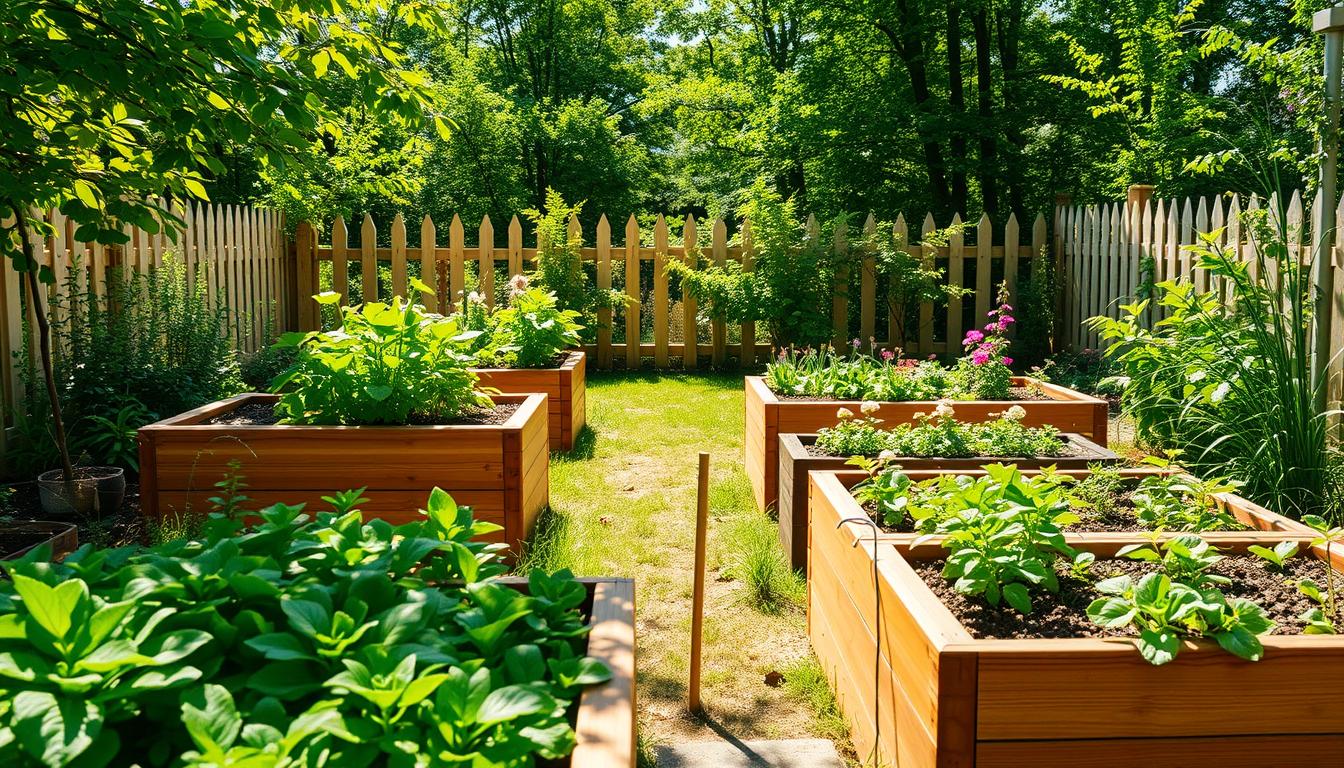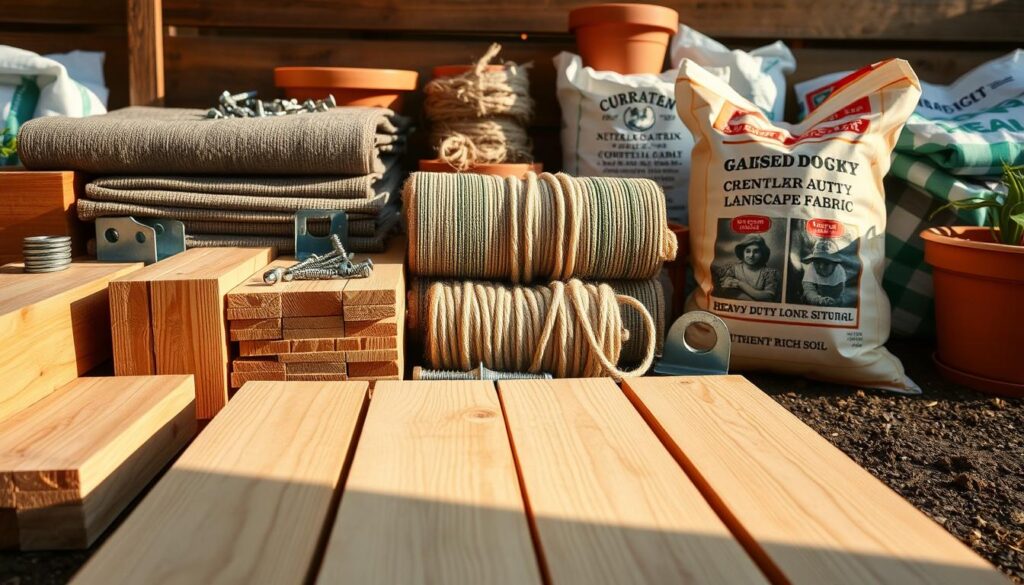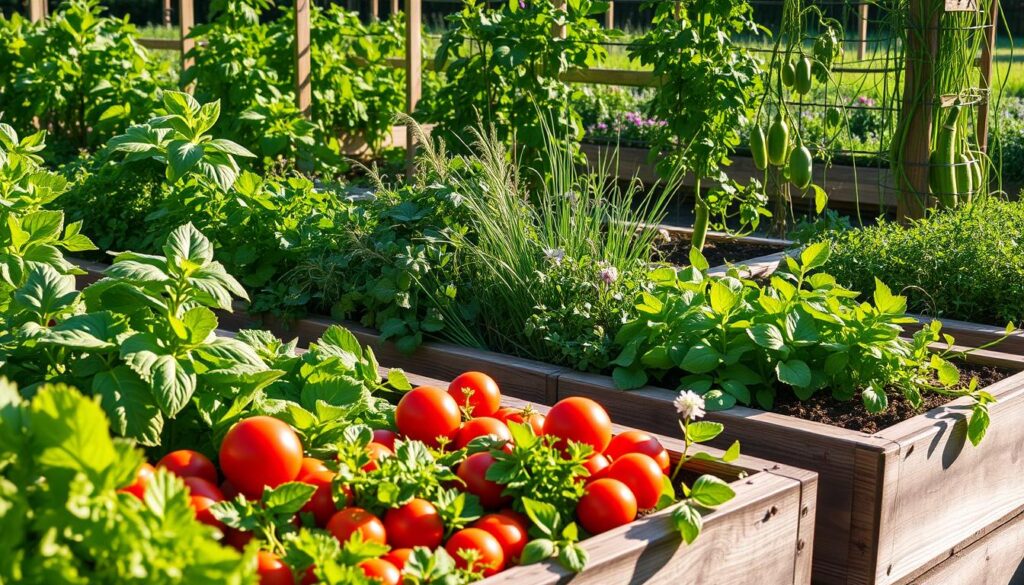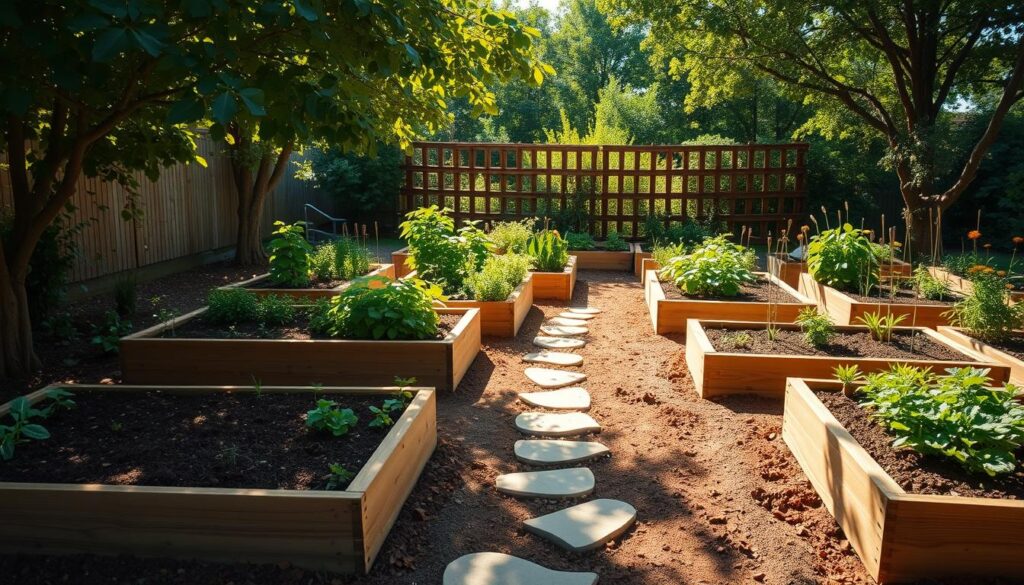
Raised Garden Beds
Ever wondered how some gardeners get their gardens to look perfect? It might be easier than you think. Raised garden beds are changing backyards in America, helping both new and experienced gardeners.
These elevated spaces are more than a trend. They’re a big help for gardeners wanting better yields and less work. Raised beds are popping up everywhere, from small balconies to big yards, making gardening easier and healthier.
Ready to start? This guide will cover everything about raised garden beds. We’ll look at their benefits, give building tips, and show off creative designs. Whether you want delicious tomatoes or beautiful flowers, let’s get your garden growing – up high!
Benefits of Raised Garden Beds for Home Gardening
Raised vegetable beds bring many advantages to home gardeners. They turn your garden into a lush spot for fresh veggies. Let’s look at the main benefits that make raised beds a favorite among gardeners.
Improved Soil Control and Drainage
Raised beds let you control the soil perfectly. You can mix the right nutrients and organic matter for your plants. The design also helps with drainage, keeping roots dry and preventing diseases.
Reduced Back Strain and Easier Maintenance
Gardening is easier with raised beds. You don’t have to bend or kneel as much, which is good for your back. Weeding and picking veggies are also simpler, as you can reach them easily.
Extended Growing Season
Raised beds warm up quicker in spring and stay warm longer in fall. This means you can plant earlier and harvest later. Some gardeners even use covers or hoop houses to grow longer.
Adding raised beds to your garden improves soil, makes maintenance easier, and extends the growing season. These perks make raised beds a great choice for all gardeners, whether you’re new or experienced.
Essential Materials for Building Raised Garden Beds
Building your own raised garden beds is an exciting project for any gardening enthusiast. To get started, you’ll need a few key materials. Let’s explore what you’ll need to bring your garden beds ideas to life.

Lumber is the foundation of most raised beds. Cedar and redwood are popular choices because they resist rot well. For a budget-friendly option, consider pressure-treated pine. Composite boards offer durability without chemicals leaching into your soil.
Hardware is crucial for assembling your beds. You’ll need galvanized screws or deck screws to join the boards. Corner brackets can add extra stability to your structure. Don’t forget a roll of landscape fabric to line the bottom of your beds, preventing weeds from creeping in.
- Tools: Drill, saw, measuring tape, level
- Soil components: Topsoil, compost, peat moss
- Optional: Irrigation system, trellises for climbing plants
For creative garden beds ideas, think outside the box. Repurpose old pallets, metal troughs, or even vintage bathtubs. These unique materials can add character to your garden while serving as functional growing spaces. With these essentials in hand, you’re ready to start building your perfect raised garden beds.
DIY Garden Beds: Step-by-Step Construction Guide
Building your own raised garden beds is a fun project. It can change your outdoor area for the better. This guide will show you how to make your own garden beds, from picking the right spot to setting up your new gardening spot.
Choosing the Perfect Location
Find a sunny spot for your raised bed. Most veggies need at least 6 hours of sunlight a day. Think about how close it is to water and how easy it is to get to for upkeep. Stay away from areas that flood or are near big trees that might steal nutrients.
Preparing the Ground
Clear the area of grass and weeds. Use a rake or shovel to level the ground. To stop weeds, put down cardboard or landscape fabric first. This helps your garden beds last longer.
Assembly Instructions
Begin by setting up your bed frame as you want it. Use wood like cedar or redwood that won’t rot. Use screws or brackets to hold the corners together. If your bed is over 12 inches tall, add stakes every few feet for support.
- Position the frame in its final location
- Fill the bed with a mix of topsoil, compost, and peat moss
- Leave about an inch of space at the top for mulch
Follow these steps to have lovely diy garden beds ready for plants. Remember, the secret to great raised bed gardening is in the planning and prep. Happy gardening!
Best Vegetables for Raised Garden Beds
Raised garden beds are great for growing many plants. Let’s look at some top vegetables for your raised garden. We’ll sort them by their growth habits and needs.

Root Vegetables
Root vegetables love the loose, well-draining soil in raised beds. Carrots, radishes, and beets do well here. The deep soil helps their roots grow straight and strong.
This leads to healthier plants and more food for you.
Leafy Greens
Lettuce, spinach, and kale are perfect for raised beds. They grow well in the controlled environment and stay moist. You can plant them again and again for a steady supply of greens.
Climbing Plants
Use climbing plants to make the most of your space. Peas, beans, and cucumbers can climb up trellises or supports. This saves room and makes picking easier, too.
| Vegetable Type | Examples | Benefits in Raised Beds |
|---|---|---|
| Root Vegetables | Carrots, Radishes, Beets | Straight growth, easy harvesting |
| Leafy Greens | Lettuce, Spinach, Kale | Consistent moisture, pest control |
| Climbing Plants | Peas, Beans, Cucumbers | Space-saving, improved air circulation |
Choosing the right vegetables for your raised garden makes it thrive. You’ll get fresh, homegrown food all season long.
Raised Flower Beds Along Fence: Design Ideas
Turn your fence into a beautiful flower display with raised beds. These vertical gardens add beauty and privacy. They also make the most of your outdoor space. Raised beds along fences are great for gardeners who want to improve their yard.

Think about different styles for your raised flower beds. Rustic wooden structures look charming and natural. Modern metal designs are sleek and contemporary. You can also use stone, brick, or recycled items for a unique look.
Choose plants that do well in these beds. Mix annuals and perennials for interest all year. Climbing plants like clematis or morning glories add height. Compact shrubs give structure and depth.
Setting up and caring for these beds needs attention. Use good soil that drains well. A drip irrigation system makes watering easier, since these beds can be hard to reach.
With good planning and creativity, your fence can become a beautiful garden feature. Let your imagination run wild and turn your fence into a colorful, textured wall.
Small Garden Layout: Maximizing Limited Space
A well-planned small garden layout can turn even the smallest outdoor space into a lush oasis. By using smart strategies and creative raised bed layouts, you can grow a lot of plants in a small area.

Square Foot Gardening Method
The square foot gardening method is great for small spaces. Divide your raised bed into 1-foot squares. Plant different crops in each square. This way, you can grow many vegetables in a small area, perfect for city gardeners.
Vertical Growing Solutions
Use your garden’s vertical space. Install trellises, cages, or hanging planters for climbing plants like peas, beans, and cucumbers. This method saves space and adds beauty to your garden.
Companion Planting Strategies
Pair plants in your raised bed for better growth. For example, basil near tomatoes improves flavor and keeps pests away. This method uses space wisely and helps plants grow well together.
- Marigolds deter pests from vegetable beds
- Carrots and onions grow well together
- Plant tall sun-loving crops on the north side of your bed
By using these strategies, you can create a productive small garden layout. With careful planning and creativity, your raised bed garden will thrive. It will provide fresh produce and beauty, even in the smallest areas.
Soil Composition and Amendments for Raised Beds
Creating the perfect soil mix is key for successful raised garden beds. A mix of topsoil, compost, and organic matter is essential. This blend ensures good drainage, holds nutrients, and allows for air to reach plant roots.

- 60% topsoil
- 30% compost
- 10% organic matter (peat moss, coconut coir, or well-rotted manure)
Soil amendments are crucial for better soil quality. Perlite helps with drainage, while vermiculite keeps water in. These additions create a great environment for your plants to grow.
Keeping the right pH balance is vital for nutrient uptake. Most veggies do well in slightly acidic soil with a pH of 6.0 to 7.0. Regular soil tests help adjust the pH, ensuring your plants grow well.
To keep your raised beds productive, add compost or well-rotted manure each spring. This replenishes nutrients and keeps the soil healthy, supporting plant growth all season.
Creating a Successful Strawberry Garden in Raised Beds
Growing strawberries in raised beds is a fun way to enjoy fresh berries. You can turn your outdoor space into a productive and beautiful area. Let’s look at how to make a thriving strawberry patch in raised beds.
Best Strawberry Varieties
Pick strawberry varieties that fit your climate and goals. Ever-bearing types give fruit all season, while June-bearing types have a big harvest in early summer. Some top picks are:
- Ozark Beauty (ever-bearing)
- Chandler (June-bearing)
- Seascape (day-neutral)
Planting Techniques
When planting strawberries in raised beds, spacing is key. Plant them 12-18 inches apart in rows, with 24 inches between rows. Make sure the crown is at soil level when planting.

Maintenance Tips
Keep your strawberry garden healthy with these tips:
- Water deeply once a week, avoiding leaf wetness
- Mulch with straw to retain moisture and prevent weeds
- Remove runners to encourage plant vigor
- Fertilize with a balanced, organic fertilizer in spring
Follow these tips, and your raised bed strawberry garden will thrive. You’ll get sweet, juicy berries all season.
Seasonal Maintenance of Raised Garden Beds
Keeping your raised garden beds in top shape all year is crucial for a great vegetable garden. Let’s look at the key tasks for each season to make sure your garden does well.

Spring is when gardening starts. First, test your soil and add what it needs. Clean out your raised beds and turn the soil over. It’s a good time to plant cool-season crops like peas and lettuce.
Summer is when your garden grows fast and you start to harvest. Make sure to water your raised garden beds well and often, even when it’s dry. Watch for pests and diseases and fix them quickly. Mulch around your plants to keep the soil moist and stop weeds.
Fall is when you harvest most of your vegetables. Clear out old plants and add compost to the soil. Plant cover crops to protect and improve the soil during winter. You can also plant cool-season vegetables for a late harvest or to grow through winter.
Winter doesn’t mean you can’t garden. Use row covers or cold frames to protect your raised beds from bad weather. This is a great time to plan next year’s garden and order seeds. If you’re up for it, try growing hardy vegetables like kale or carrots.
| Season | Main Tasks | Vegetable Garden Focus |
|---|---|---|
| Spring | Soil testing, bed preparation | Planting cool-season crops |
| Summer | Watering, pest management | Maintaining growth, early harvests |
| Fall | Soil replenishment, cover crops | Main harvest, planting for winter |
| Winter | Bed protection, planning | Growing hardy vegetables, preparation |
By following these seasonal tips, you’ll keep your raised garden beds healthy and productive all year. This ensures your vegetable garden thrives in every season.
Creative Raised Bed Ideas for Modern Gardens
Make your outdoor area stand out with new raised bed ideas. Modern gardens now have unique designs that use space well and look good. Let’s look at some creative garden bed ideas that will spark your creativity and love for gardening.
Multi-Level Designs
Terraced raised beds give a fresh twist to traditional garden layouts. These multi-tiered structures add depth and make your garden a standout. Cascading planters are great for small yards or balconies, turning vertical space into a garden. These designs are not only stylish but also increase the space for your plants.
Material Combinations
Get creative with material combinations for eye-catching raised bed ideas. Try pairing sleek metal with warm wood for a modern look. Concrete blocks are durable and can be arranged in many ways. Eco-friendly gardeners can use old tires or pallets for unique and green garden beds.
Decorative Elements
Add a personal touch to your garden beds with decorative elements. Built-in seating lets you relax among your plants. Use mosaic tiles or painted designs for artistic edging. Integrated lighting highlights your plants at night, making your garden a beautiful spot for evening walks.
Leave a Reply